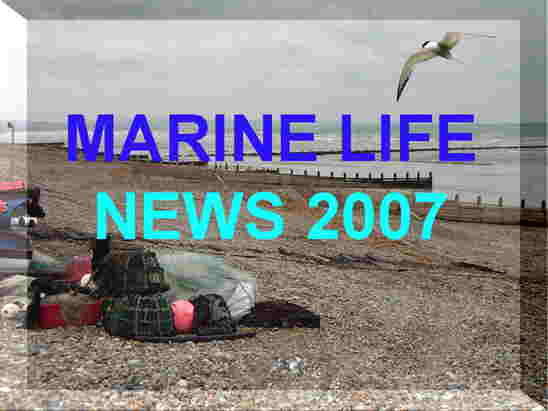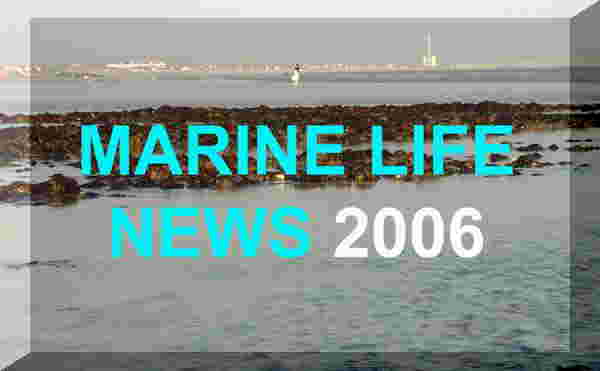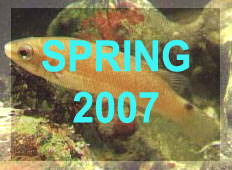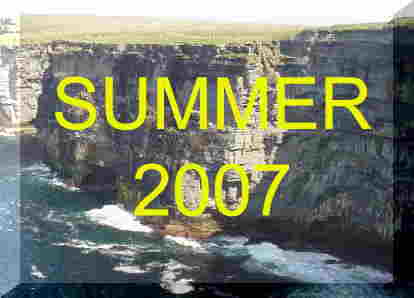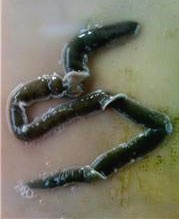LATEST
NEWS:
27
September 2007

Eider
Duck Somateria
mollissima
swallowing
a Bullhead
Photograph
by Dave Pullan
Eider
Ducks usually eat mussels
and perhaps other molluscs
so
this is a most extraordinary photograph.
Dave
Pullan Photographic Portfolio
24-25
September 2007
The
male
Northern Bottle-nosed Whale,
Hyperoodon
ampullatus, beached in Loch
Roag, on the west of the Hebridean island of Lewis,
before managing to free itself. But the undernourished whale was found
dead on the second day at Garynahine.
Seven
Northern
Bottle-nosed Whales were seen at the weekend
at the entrance to Loch Roag where they stayed for two days before moving
off and leaving the ill one behind.
22
September 2007
Numerous
(28+)
Snakelocks Anemone Shrimp, Periclimenes
sagittifer, were found during a dive off Swanage
Pier
in Dorset. These small colourful shrimps look bluish (the pincers are blue
and white striped) amongst the green tentacles of the symbiotic Snakelocks
Anemone, Anemonia
viridis. The shrimps can reach about
30 mm in size and are almost always found with the sea
anemone. This is the first known sighting
of Periclimenes sagittifer
in the shallow seas around mainland Britain.
Before
this report, the most northerly sightings were regular reports from around
the Channel
Islands.
19
September 2007
A
large Deepwater Crawfish,
Palinurus
mauretanicus*,
has been caught by commercial fishermen about 200 miles (321 km) from Newlyn,
Cornwall. Measuring 59.5 cm (23 in) long, this is a large specimen of a
species usually found in more southerly seas and an unusual capture off
British coasts. It has been kept in captivity in the Blue
Reef Aquarium at Newquay. The
usual species of Spiny Lobster
is Palinurus
elephas, and this is found off the
south and west of the British Isles.
(*
Species assumed without precise ID.)
Palinurus
mauretanicus are recorded off the west
of Ireland to 53°N, but only below 180 metres, normally below 200 metres.
As there is not much water of that depth close to the UK, they are very
infrequent in British landings. Catches in the Western Mediterranean can
be of 200 to 300 crayfish at a time, presumably these are breeding groups.
More
Information by Declan Quigley (Link)
BMLSS
Crustacea
BMLSS
Public Aquaria List
September
2007
In
the last three weeks we have been observing the fragile String Jellyfish,
Apolemia
uvaria,
in areas of plankton over deep water in various places off Land's
End, Cornwall.
BMLSS
Other Siphonophores
14
September 2007
An
Edible
Crab,
Cancer
pagurus, landed at Shoreham,
Sussex,
and caught in the Selsey area of West Sussex, weighed 3.9 kg and measured
270 mm across its carapace. This is the largest
crab on record from Sussex and as big as they get anywhere.
BMLSS
Edible Crabs
Marine
Life of Sussex
12
September 2007
Working
from a survey vessel south-east of Suðuroy
in the Faroe Islands (north
of Scotland), we witnessed 40 Fin Whales,
Balaenoptera
physalis, plus 10 unidentified large whales
(probably more Fin Whales)
and one Minke Whale, Balaenoptera
acutorostrata. This was over the course
of a sail line some 50 miles in length. We thought we also saw a Sei
Whale, Balaenoptera borealis.
I
am sure there are other places in the world that this spectacle occurs,
but this area seems to hold a staggering number of these huge cetaceans.
I have only encountered such numbers once before, in 2002
and in the same region.
BMLSS
Cetacea
10
September 2007
We
were hauling monkfish nets about 20 miles out to sea off Cornwall when
a grey strange worm-like creature
came up through the net hauler, it had wrapped itself up in the net. It
looks like something out of X-files for sure. It had no real visible eyes
or mouth. After initially wriggling round frantically for a couple of minutes;
it played dead. After taking a couple of photographs with my phone, I scooped
it up with the trusty shovel and flipped it over the side. It promptly
swam away in an eel or snake-like fashion. It was about 60 cm long.
Report
and Images by Sharpshooter on the World
Sea Fishing Forum
The Nemertean
"worm" was identified by myself and
Richard
Lord (Guernsey) of the genus Cerebratulus.
It
could very well be of Cerebratulus marginatus
(definitely Nemertean, and confident it's a Cerebratulus).
The species can be up to one metre long but can contract to less than half
their extended length.
Gibson
(1982) notes that Cerebratulus marginatus
is rarely found on the lower shore and usually obtained when dredging in
sandy or muddy sediments at depths of 20-150 metres or more. It can be
caught on fishing lines when mussel flesh is
used as bait. It is a strong swimmer and often rotates about it's own longitudinal
axis. It tends to fragment when handled. When I get them in a sample they
are always in pieces!
NBN
Distribution Map
Notes
by Peter Barfield (Sea-nature
Studies)
5 September
2007
An
astonishing 462+ Basking Sharks, Cetorhinus
maximus, were seen in the morning between
Longships and The
Brisons, off the west of the Cornish mainland! Accompanying the
sharks were many Gannets,
suggesting that fish and plankton would have been present. Also, in much
the same place (10 km sq. SW 33) between
20 and 24 Risso’s Dolphins,
Grampus
griseus, and 35 Common
Dolphins Delphinus delphis, were
recorded.
BMLSS
Shark News
4 September
2007
A
young male Bottle-nosed Dolphin Tursiops truncatus,
called
"George" followed a boat into the River Adur, Shoreham-by-Sea,
Sussex, and stayed for most of the day until coaxed back out to sea by
Shoreham inshore lifeboat before it could stranded on the low neap tide.
This
particular Bottle-nosed Dolphin habitually
enters English Channel harbours, but for all of last year was found around
the French coast.
Marine
Life off Sussex
BMLSS
Cetacea
Whales
& Dolphins around the British Isles
120
Basking
Sharks,
Cetorhinus maximus,
were seen in the morning between Longships and The
Brisons, off the west of the Cornish mainland!
3
September 2007
60
Basking
Sharks, Cetorhinus maximus,
were seen in the morning between Longships and The
Brisons, off the west of the Cornish mainland!
BMLSS
Basking Sharks
26
August 2007
A
Ray's
Bream,
Brama
brama, (TL 458mm FL 380mm), found on the beach at St
Brelade's Bay (S Coast of Jersey, CI), was the first one I am aware
of in Jersey & possibly the Channel Islands?
BMLSS
Ray's Bream
25
August 2007

Sea
Hare, Aplysia fasciata
Aplysia,
the size if which (between 30 & 35 cm) indicates that it is Aplysia
fasciata. It
was photographed swimming in Helford
River, Cornwall. It was seen by Steve
Potter.
Aplysia
fasciata is the largest and the rarest of the three species of
sea hare found in the British Isles. It is an Atlantic species, found from
the Channel to Angola (South west Africa and to Brazil) and also throughout
the Mediterranean. It appears to reach its northern limit in Ireland and
along the Channel coast of England.
It
is one of the largest sea slugs in the world. The other two British species
are the relatively common Aplysia punctata variable in colour
and growing to 20 cm; and the uncommon Aplysia
depilans with different shaped back lobes,
brown or green and growing to a maximum of 30 cm.
BMLSS
Molluscs
20
August 2007
An
Almaco
Jack,
Seriola
rivoliana, was caught by an angler from a boat at the entrance
to Chichester Harbour, Sussex.
This
southern fish is rarely caught in British seas and was probably the very
first one recorded and identified
(by Dr.
William Smith-Vaniz) in the seas off Sussex.
Three
more Almaco Jacks have
been caught since the previously mentioned one, one from Grand Rocque Bay
on the west coast of Guernsey
on
29 August 2007 and
another
from just off Crantock
in north Cornwall by Newquay fisherman Phil
Trebilcock at the beginning of September
2007.
BMLSS
Seriola Jacks
15
August 2007
We
dived the 'Rosalie'
off Weybourne
in Norfolk at the weekend and saw a Tompot
Blenny, Parablennius gattorugine.
It was a fairly large one and was seen by several divers and we have some
photos. According to our books, it has never
been recorded on the east coast.
Diving
at Welbourne (Sunstar Sub-Aqua)
The
distribution of the Tompot Blenny and presence on the North sea coasts
is under investigation.

Tompot
Blenny off the Norfolk coast
Photograph
by Dawn Watson
10
August 2007
Mark
Guppy clearly spotted a Broad-billed
Swordfish,
Xiphias
gladius*,
that jumped out of the water about 800 metres from the Condor ferry beyond
Old
Harry Rocks about five miles off Poole Harbour, Dorset, in the English
Channel. (*Species assumed without precise
identification.)
BMLSS
Swordfish
2
-3 August 2007
A
young Minke Whale,
Balaenoptera
acutorostrata, followed a fishing boat
into Fraserburgh Harbour,
north-east Scotland. It became trapped with an adult Minke
Whale, believed its mother stationed outside
the harbour. Rescue was achieved by British
Divers Marine Life Rescue (BDMLR) who coaxed the young whale back to
the open sea using small boats and noise.
31
July 2007

Commercial
fisherman Dougal Lane
caught an Atlantic Bonito,
Sarda
sarda, about three miles east of Sark,
Bailiwick of Guernsey. The fish had a length of 511 mm and a whole weight
of 1331 grams.
BMLSS
Scombridae
29
July 2007
An
astonishing bright red fish misnamed as the Boar
Fish, Capros aper,
was discovered swimming around in a pool when the tide was out on Littlehampton
main beach (east of the River Arun), Sussex. It was about 75 mm long, and
I was able to scoop the rhomboidal fish up in a shell, before I allowed
it to swim away.
Report
by Mark Wright
27
July 2007
A
Northern
Bottle-nosed Whale, Hyperoodon ampullatus,
became
stranded in the River
Orwell, Suffolk, and is unlikely to survive being trapped in the estuary.
The three metres long whale was first seen around 2:00
pm in the area of the Orwell
Bridge, just outside of Ipswich.
PS:
The whale was humanely euthanased to prevent it suffering a lingering death.
BMLSS
Cetacea
Magic
Map now has a Coastal and Marine Resource Atlas
Cornish
Marine Wildlife 2006 (Ray Dennis Records)


